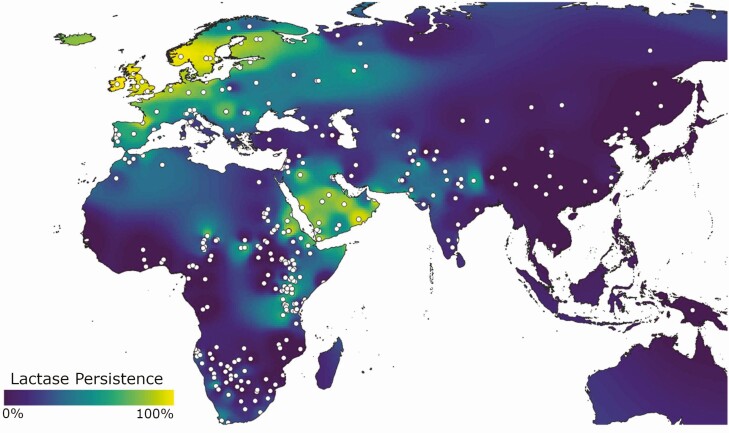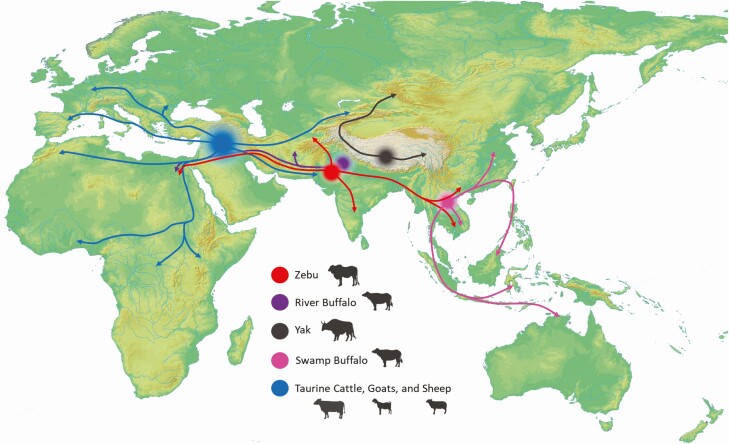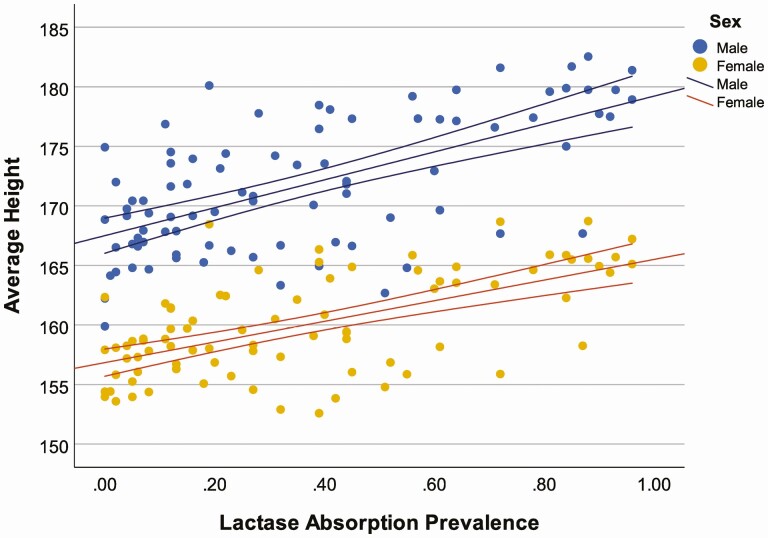{"title":"乳业和人类乳糖酶持久性的进化和后果。","authors":"Jay T Stock, Jonathan C K Wells","doi":"10.1093/af/vfad022","DOIUrl":null,"url":null,"abstract":"A stable and consistent food source is one of the most important evolutionary challenges facing any species. Mammalian young are typically born incapable of provisioning for themselves, but all mammalian species, through the production of milk, have evolved a unique mechanism for transferring fat, proteins, sugar, as well as immunoglobins, hormones, and nutrients to their young, fueling neural development and growth throughout infancy. Milk is an essential resource for all growing mammals until they are physically able to forage and support themselves nutritionally. It has evolved as a means for mothers to synthesize food for their young, and to provide the intestinal bacteria to optimize an infant’s absorption of nutritional resources (Hinde and German, 2012). For the majority of human societies through time and space, the nutritional role of milk, like all mammals, is related to direct maternal–infant provisioning. While human hunter-gatherers typically do not consume non-human milk or dairy products, with the domestication of ruminant animals many human societies harnessed nonhuman sources of milk for the production of secondary dairy products such as cheese and yogurt, or for direct consumption (Roffet-Salque et al., 2018). While the transition to agriculture was variable in expression based on differences in local ecology and cultural history, the origin of farming and the domestication of plants and animals had a dramatic impact on the temporal and geographic patterning of milk production and consumption across the world (Stock et al., 2023). The transition from hunting and gathering to agricultural subsistence, often referred to as the “Neolithic Revolution,” is characterized by the development of human control over the reproduction of plants and animals, as well as their evolution through artificial selection. This involved a reduction in dietary breadth toward dependence on one or a few highly productive domesticated plants or animals, and has generally been associated with a greater proportion of dietary carbohydrates relative to protein and an increased prevalence of nutritional deficiencies (Cordain et al., 2000). The agricultural transition marks a significant change in human interaction with the natural world, where humans shifted from being predominantly influenced by natural environments to being the agents of environmental change in natural systems (Stephens et al., 2019). In this context, it is often viewed as the beginning of a series of changes in human social organization that directly result from the rise of food production and the storage of surpluses. These include sedentism, property ownership, social hierarchy, specialist craft production and related technological change, greater population density, and increased frequencies of infectious diseases and zoonotic diseases associated with domestic animals. Collectively, these changes have generally been seen This is an Open Access article distributed under the terms of the Creative Commons Attribution License (https://creativecommons.org/licenses/by/4.0/), which permits unrestricted reuse, distribution, and reproduction in any medium, provided the original work is properly cited. © Stock, Wells Implications","PeriodicalId":72200,"journal":{"name":"Animal frontiers : the review magazine of animal agriculture","volume":"13 3","pages":"7-13"},"PeriodicalIF":4.2000,"publicationDate":"2023-06-01","publicationTypes":"Journal Article","fieldsOfStudy":null,"isOpenAccess":false,"openAccessPdf":"https://www.ncbi.nlm.nih.gov/pmc/articles/PMC10266752/pdf/","citationCount":"2","resultStr":"{\"title\":\"Dairying and the evolution and consequences of lactase persistence in humans.\",\"authors\":\"Jay T Stock, Jonathan C K Wells\",\"doi\":\"10.1093/af/vfad022\",\"DOIUrl\":null,\"url\":null,\"abstract\":\"A stable and consistent food source is one of the most important evolutionary challenges facing any species. Mammalian young are typically born incapable of provisioning for themselves, but all mammalian species, through the production of milk, have evolved a unique mechanism for transferring fat, proteins, sugar, as well as immunoglobins, hormones, and nutrients to their young, fueling neural development and growth throughout infancy. Milk is an essential resource for all growing mammals until they are physically able to forage and support themselves nutritionally. It has evolved as a means for mothers to synthesize food for their young, and to provide the intestinal bacteria to optimize an infant’s absorption of nutritional resources (Hinde and German, 2012). For the majority of human societies through time and space, the nutritional role of milk, like all mammals, is related to direct maternal–infant provisioning. While human hunter-gatherers typically do not consume non-human milk or dairy products, with the domestication of ruminant animals many human societies harnessed nonhuman sources of milk for the production of secondary dairy products such as cheese and yogurt, or for direct consumption (Roffet-Salque et al., 2018). While the transition to agriculture was variable in expression based on differences in local ecology and cultural history, the origin of farming and the domestication of plants and animals had a dramatic impact on the temporal and geographic patterning of milk production and consumption across the world (Stock et al., 2023). The transition from hunting and gathering to agricultural subsistence, often referred to as the “Neolithic Revolution,” is characterized by the development of human control over the reproduction of plants and animals, as well as their evolution through artificial selection. This involved a reduction in dietary breadth toward dependence on one or a few highly productive domesticated plants or animals, and has generally been associated with a greater proportion of dietary carbohydrates relative to protein and an increased prevalence of nutritional deficiencies (Cordain et al., 2000). The agricultural transition marks a significant change in human interaction with the natural world, where humans shifted from being predominantly influenced by natural environments to being the agents of environmental change in natural systems (Stephens et al., 2019). In this context, it is often viewed as the beginning of a series of changes in human social organization that directly result from the rise of food production and the storage of surpluses. These include sedentism, property ownership, social hierarchy, specialist craft production and related technological change, greater population density, and increased frequencies of infectious diseases and zoonotic diseases associated with domestic animals. Collectively, these changes have generally been seen This is an Open Access article distributed under the terms of the Creative Commons Attribution License (https://creativecommons.org/licenses/by/4.0/), which permits unrestricted reuse, distribution, and reproduction in any medium, provided the original work is properly cited. © Stock, Wells Implications\",\"PeriodicalId\":72200,\"journal\":{\"name\":\"Animal frontiers : the review magazine of animal agriculture\",\"volume\":\"13 3\",\"pages\":\"7-13\"},\"PeriodicalIF\":4.2000,\"publicationDate\":\"2023-06-01\",\"publicationTypes\":\"Journal Article\",\"fieldsOfStudy\":null,\"isOpenAccess\":false,\"openAccessPdf\":\"https://www.ncbi.nlm.nih.gov/pmc/articles/PMC10266752/pdf/\",\"citationCount\":\"2\",\"resultStr\":null,\"platform\":\"Semanticscholar\",\"paperid\":null,\"PeriodicalName\":\"Animal frontiers : the review magazine of animal agriculture\",\"FirstCategoryId\":\"1085\",\"ListUrlMain\":\"https://doi.org/10.1093/af/vfad022\",\"RegionNum\":0,\"RegionCategory\":null,\"ArticlePicture\":[],\"TitleCN\":null,\"AbstractTextCN\":null,\"PMCID\":null,\"EPubDate\":\"\",\"PubModel\":\"\",\"JCR\":\"\",\"JCRName\":\"\",\"Score\":null,\"Total\":0}","platform":"Semanticscholar","paperid":null,"PeriodicalName":"Animal frontiers : the review magazine of animal agriculture","FirstCategoryId":"1085","ListUrlMain":"https://doi.org/10.1093/af/vfad022","RegionNum":0,"RegionCategory":null,"ArticlePicture":[],"TitleCN":null,"AbstractTextCN":null,"PMCID":null,"EPubDate":"","PubModel":"","JCR":"","JCRName":"","Score":null,"Total":0}
引用次数: 2
Dairying and the evolution and consequences of lactase persistence in humans.
A stable and consistent food source is one of the most important evolutionary challenges facing any species. Mammalian young are typically born incapable of provisioning for themselves, but all mammalian species, through the production of milk, have evolved a unique mechanism for transferring fat, proteins, sugar, as well as immunoglobins, hormones, and nutrients to their young, fueling neural development and growth throughout infancy. Milk is an essential resource for all growing mammals until they are physically able to forage and support themselves nutritionally. It has evolved as a means for mothers to synthesize food for their young, and to provide the intestinal bacteria to optimize an infant’s absorption of nutritional resources (Hinde and German, 2012). For the majority of human societies through time and space, the nutritional role of milk, like all mammals, is related to direct maternal–infant provisioning. While human hunter-gatherers typically do not consume non-human milk or dairy products, with the domestication of ruminant animals many human societies harnessed nonhuman sources of milk for the production of secondary dairy products such as cheese and yogurt, or for direct consumption (Roffet-Salque et al., 2018). While the transition to agriculture was variable in expression based on differences in local ecology and cultural history, the origin of farming and the domestication of plants and animals had a dramatic impact on the temporal and geographic patterning of milk production and consumption across the world (Stock et al., 2023). The transition from hunting and gathering to agricultural subsistence, often referred to as the “Neolithic Revolution,” is characterized by the development of human control over the reproduction of plants and animals, as well as their evolution through artificial selection. This involved a reduction in dietary breadth toward dependence on one or a few highly productive domesticated plants or animals, and has generally been associated with a greater proportion of dietary carbohydrates relative to protein and an increased prevalence of nutritional deficiencies (Cordain et al., 2000). The agricultural transition marks a significant change in human interaction with the natural world, where humans shifted from being predominantly influenced by natural environments to being the agents of environmental change in natural systems (Stephens et al., 2019). In this context, it is often viewed as the beginning of a series of changes in human social organization that directly result from the rise of food production and the storage of surpluses. These include sedentism, property ownership, social hierarchy, specialist craft production and related technological change, greater population density, and increased frequencies of infectious diseases and zoonotic diseases associated with domestic animals. Collectively, these changes have generally been seen This is an Open Access article distributed under the terms of the Creative Commons Attribution License (https://creativecommons.org/licenses/by/4.0/), which permits unrestricted reuse, distribution, and reproduction in any medium, provided the original work is properly cited. © Stock, Wells Implications




 求助内容:
求助内容: 应助结果提醒方式:
应助结果提醒方式:


